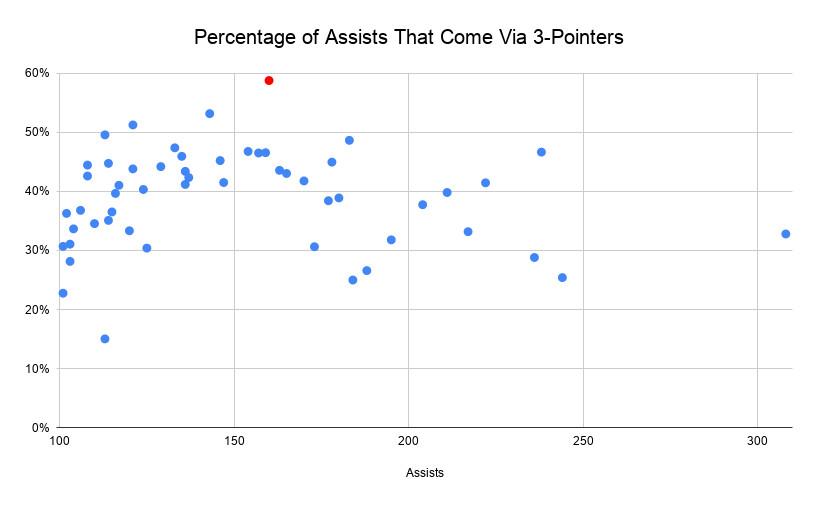
Sort every team in NBA history by its per-game point differential, and a new contender rises to the very top of the list.
Best Per-Game Point Differentials in NBA History
Yes, 31 games into the 2019-20 season, the Milwaukee Bucks are ahead of the 73-win Warriors, the 72-win Bulls, the 33-game-win-streak Lakers, and every other team the league has ever known. There are many ways to praise these Bucks—and we at The Ringer have tried a whole bunch—but their historic point differential might be the simplest, most illuminating fact that illustrates their start.
The Bucks still have plenty to prove in the playoffs—it’s a crucial season for the franchise, and star Giannis Antetokounmpo is up for an extension next summer. But for regular-season purposes, the Bucks have already proved their worth: Last season, they won 60 games and claimed the NBA’s best record; this season, they’re no. 1 in defensive rating and no. 2 on offense. Barring catastrophic injury luck, they’re a lock to earn home-court advantage again. All they have left to accomplish before April is to chase history—and so far, they’re on pace to make a run.
The Bucks’ 27-4 start has them on pace for 71 wins; only the 2015-16 Warriors and 1995-96 Bulls reached 70. And while it’s perhaps too early to seriously contemplate Milwaukee’s chance to join them, a few key factors bolster their odds.
First is that point differential, a better predictor of future success than pure win-loss record. The Bucks have so far outscored their opponents by 418 points—the second-best mark in league history through 31 games. In this stat, only the 1971-72 Bucks with Kareem Abdul-Jabbar rate better.
The Bucks are winning games without breaking much of a sweat; for instance, they didn’t trail at any point in the last five minutes in any game during their recent 18-game win streak. Their propensity for blowout wins also helps keep their top players fresh, for both the playoffs and the rest of the regular season if they are to approach 70 wins.
All these easy wins—plus some issues with foul trouble—have afforded Giannis far more rest than the league’s other stars. This chart shows the average workload for the league’s top 10 players this season, according to The Ringer’s recent Top 25 Players of the First 25ish Games rankings, and their minutes rank among qualified players. Antetokounmpo brings up the rear.
NBA Stars’ Nightly Workloads
Beyond Antetokounmpo, no other Milwaukee player averages even 30 minutes per game or ranks in the top 100 leaguewide. The Bucks shouldn’t tire out by the spring because none of their best players are maintaining unmanageable workloads now—even as they win at historic margins.
Workloads for Bucks Rotation Players
All of the Bucks’ strategic advantages from last season, their first with coach Mike Budenholzer, have carried over to this season. Like last season, when they led the league in defensive rating, the Bucks’ defense is built around stout rim protection: They allow the league’s lowest rate of shots within 3 feet and one of the lowest free throw rates.
When opposing players do manage to penetrate into the paint against Milwaukee, well, good luck converting. Out of 220 players who have defended 50-plus shots within 6 feet of the basket, Brook Lopez ranks first, Robin Lopez second, and Giannis third in lowest field goal percentage allowed.
On offense, meanwhile, the Bucks are built to optimize efficiency in the modern NBA, with a four-out, one-in framework that revolves around Giannis. The reigning MVP leads the league, again, in made baskets in the restricted area, and he leads in shooting percentage (76 percent) among 82 players who have taken at least 100 shots there.
His teammates give him space to mash down low, and the flexibility to kick out a pass if the defense collapses. Out of Giannis’s 5.5 assists per game, 58 percent have led to 3-pointers—best in the league for everyone with at least 100 total assists this season, according to data derived from pbpstats.com. Giannis is the red dot in this graph. (The dot to the far right, with 64 more assists than anyone else, is LeBron James, whose partnership with Anthony Davis is by far the most fruitful in the league.)

Besides Thanasis Antetokounmpo, who’s played six games in garbage time, every Bucks player is averaging at least four 3-point tries per 36 minutes. That list includes offseason additions like Kyle Korver, one of the greatest shooters in league history; Giannis himself, who is taking and making 3s at an unprecedented rate; and the rotation of defensively sound big men, like Robin Lopez, who has already made more 3s this season than in the entirety of his NBA career before now.
Milwaukee’s pace also helps, as the Bucks play at the fastest clip in the league. All else being equal, favorites should want to play quicker. More possessions means more opportunities for a talent imbalance to manifest on the scoreboard, so Milwaukee’s rate of play can both help the team avoid upsets and increase its margin of victory against overmatched teams.
Avoiding upsets has indeed helped the Bucks amass their sizable early lead in the standings. They’re a perfect 18-0 against teams with losing records (as well as a league-best 9-4 against those with even or winning records), and such game-to-game consistency could boost their record even further. The Bucks have plenty of remaining games against bad teams; their remaining slate of opponents ranks below average as a group, and they’ve already finished their season matchups against formidable opponents like the Clippers and Jazz.
The upcoming schedule looks especially soft; after a clash against the 76ers on Christmas, the Bucks’ next 10 games come against sub-.500 teams. That takes them through the halfway point of the season—meaning the Bucks could still be on pace for 70-plus wins for at least another month.
It almost goes without saying that obstacles remain en route to such a lofty goal. An injury could scramble their plans. They might rest players even more down the stretch if they clinch the no. 1 seed early. Basic regression also dictates that the Bucks won’t continue playing better than any team in league history has over a full season. FiveThirtyEight’s forecast pegs the Bucks’ average final win total at just 63; Basketball-Reference places the expectation at 65.
The Bucks’ winning strategy, while beneficial in the long run, could also add a surprise loss or two to Milwaukee’s record. All their 3-point shooters might run cold on the same night, or all their opponents might run hot, as the Bucks’ rim-centric focus on defense means opponents take a lot of 3s against Giannis and the Lopez brothers.
Even then, the Bucks still might be strong enough on offense to win those games—they’re 11-4 this season when allowing 15-plus made 3s. When their opponent makes fewer than 15 3s, they’re undefeated. It might be a requirement to shoot lights out from range to compete with Milwaukee.
The Bucks have already weathered an injury to Khris Middleton, and are currently making do without Eric Bledsoe—the chief offensive creators behind Giannis. And Antetokounmpo himself has never suffered a major injury (knock on wood) or missed more than 10 games in a season. Despite all the Bucks’ massive wins, moreover, they haven’t lost a single game in blowout fashion. Milwaukee’s defeats have come by three points, four points, five points (in overtime), and 11 points—and in that latter loss, to Boston, it led late in the third quarter.
Whether the Bucks’ torrid regular-season clip will persist through the playoffs is a trickier problem to parse—and one that can’t really be answered until the intensity amplifies in the spring. But for the next four months, at least, Milwaukee should continue rampaging through the regular-season competition. Two months in, they haven’t slowed at all.
Team stats through Sunday’s games; player stats through Saturday.

